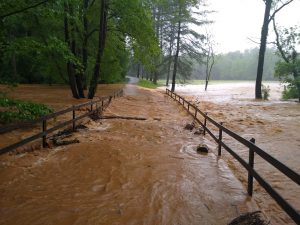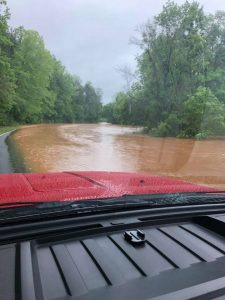Flood Resources

Flooding
Flooding occurs when a normally dry area becomes covered in water or some other liquid. Flooding is often caused by rain. However, it can also happen because of dam failures, melting snow and ice, seeping groundwater, and damaged water or sewer pipes. Your property can be damaged by flooding even if you don’t live next to a stream or lake! These types of flooding can be hard to predict.
Floodplains
Flooding of land near waterways (such as streams, rivers, and lakes) during storms can occur because of rising water levels. These areas are called floodplains. Flooding can vary with each storm based on the amount of rain, how hard it is raining, and how long it rains. Several measures are in place to help protect residents from flooding. The United States Geological Survey monitors water levels and has an alert system in place. In many locations, the Federal Emergency Management Agency (FEMA) has mapped flood prone areas and estimated how likely they are to flood. These maps are called Flood Insurance Rate Maps or FIRMs.
Myth: The “100 Year Flood” should only happen once every 100 years.
Fact: The “100 Year Flood” actually has a 1% chance of happening in any given year. These floods can occur far more often than once every hundred years. Homes in these areas have a 26% chance of such a flood occurring during a 30 year mortgage period.
National Flood Insurance Program
The National Flood Insurance Program (NFIP) was created by Congress in 1968 to reduce the risks associated with flooding. Such risks include those to lives, property, or the financial stability of a community. Nearly every flood prone area in North Carolina, including Rutherfordton, is part of this program.
Because it is a part of the NFIP, Rutherfordton can receive federal aid after the president declares a disaster. Rutherfordton residents can also purchase federally subsidized flood insurance (whether or not their property is in a FEMA mapped floodplain). Federally subsidized flood insurance costs about half as much as non-subsidized flood insurance.
In return, Rutherfordton has to take steps to reduce local flooding risks. These include adopting and enforcing floodplain development rules and requiring permits for any activity that disturbs land in a FEMA mapped floodplain.
Hazard Mitigation Planning
The Town and Rutherford County participate in planning to mitigate the effects of potential disasters. Floodplains represent one of the potential risks covered by these planning efforts. The link below represents current and proposed hazard mitigation planning.

